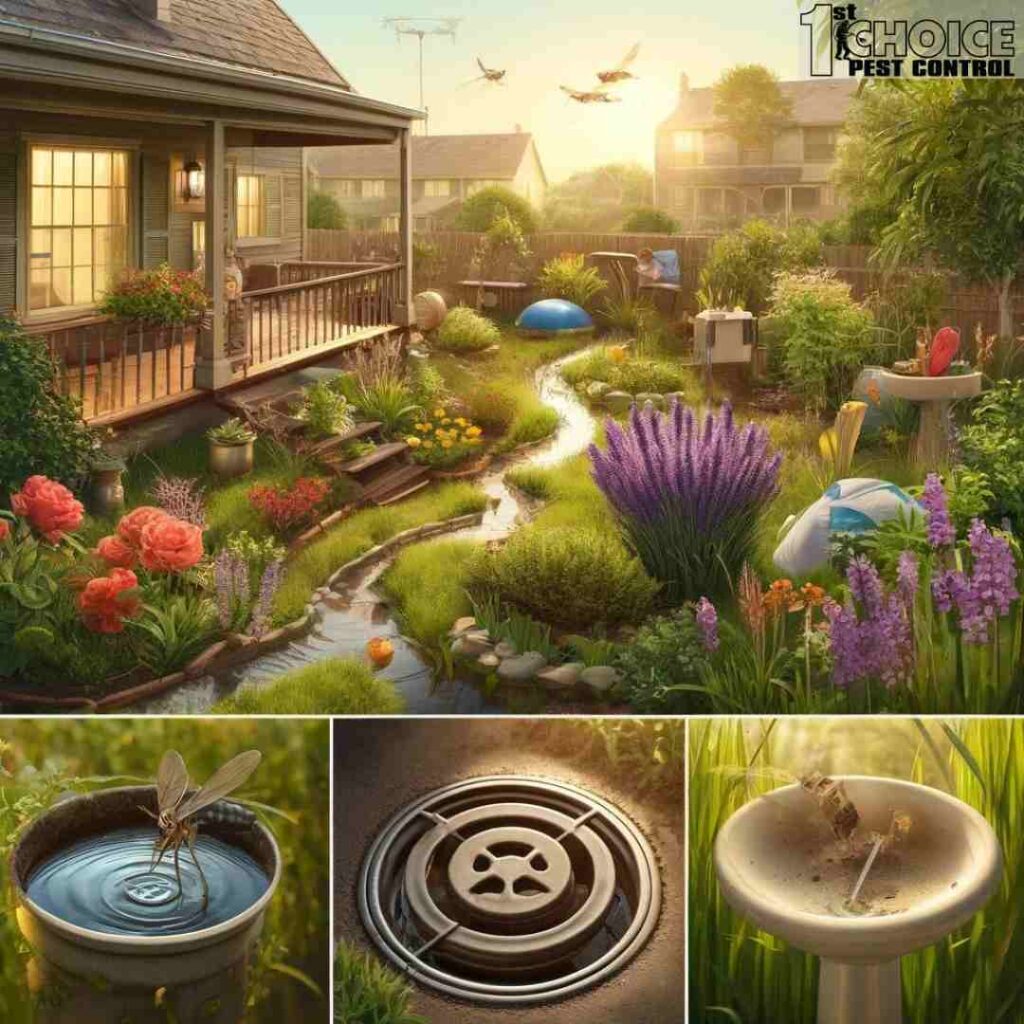Mosquito Hotspots: Essential Areas in Your Home and Yard
Mosquitoes are more than just a nuisance; they are carriers of some of the most dangerous diseases, including Zika, West Nile virus, and dengue fever. Protecting your family’s health starts right in your backyard—and inside your home. Understanding where mosquitoes breed and congregate can help you prevent these pests from becoming a significant problem. This blog post will guide you through identifying and tackling mosquito hotspots around your home and yard. By mapping out these critical areas and taking proactive steps, you can reduce mosquito populations and enjoy a safer, more comfortable living environment. Let’s dive into the common indoor and outdoor breeding sites to watch for and how to address them effectively.
Outdoor Breeding Grounds
The battle against mosquitoes extends to the great outdoors, where natural and man-made water collections provide ideal breeding sites. Key outdoor locations to monitor include stagnant water in birdbaths, clogged rain gutters, and the saucers of outdoor plant containers. Regularly changing the water in birdbaths, cleaning out gutters to ensure proper drainage, and removing excess water from plant saucers can drastically reduce mosquito populations.
Additionally, be wary of less obvious breeding grounds that might be overlooked. Accumulated water in tarps used to cover pools, boats, or firewood can create a hidden haven for mosquito larvae. Similarly, hollows in trees or depressions in the lawn that collect rainwater can become mosquito breeding sites if not properly managed. Filling these depressions and ensuring that tarps are stretched tight so water cannot pool are simple fixes that can have a significant impact.
Outdoor containers such as buckets, kiddie pools, and unused flowerpots should also be stored upside down or in a sheltered area to prevent water collection. Regular yard maintenance, including trimming tall grass and shrubs, can reduce adult mosquito shelter and further discourage them from settling in your yard.
By keeping an eye on these common and uncommon outdoor spots, you can maintain a yard that is not only beautiful but also minimizes the risks associated with mosquito infestations.
Creating a Mosquito Map
Taking control of the mosquito situation at home goes beyond sporadic checks; it demands a proactive and strategic approach. An effective technique for maintaining vigilance over mosquito activity is to create a ‘mosquito map’ of your property. This involves a few detailed steps:
- Initial Inspection: Begin by conducting a comprehensive inspection of your entire property, both indoors and outdoors. Look for any signs of standing water or potential breeding grounds, such as clogged gutters, water-filled plant saucers, or even small puddles near your foundation.
- Mapping: Use a simple map layout of your property to mark these identified spots. You can create this map digitally using various apps or traditionally with paper and pen. The key is to have a visual representation of all potential trouble areas.
- Documentation and Monitoring: As you mark the map, take notes on the condition and specifics of each site—how much water, the type of area, shade, and any nearby plants. This information will be crucial for both treatment and future prevention.
- Regular Updates: Mosquito breeding sites can change with seasons and weather conditions. Regularly updating your map as you eliminate problems or discover new ones will help you stay organized and focused in your efforts. This might mean weekly updates during peak mosquito seasons or following heavy rains.
- Visual Aids: Documenting these areas visually aids in routine checks and ensures no spot is overlooked. It also helps in understanding the patterns of mosquito activity over time, which can inform better, more targeted control strategies.
- Collaboration with Professionals: If you’re working with a pest control professional, your mosquito map can be invaluable. Share it with them to provide a clear overview of your property’s specific challenges. They can then tailor their treatments more effectively, focusing on the hotspots identified on your map.
- Educational Tool: Lastly, your mosquito map can serve as an educational tool for your household. It helps everyone understand where precautions are needed and encourages regular participation in control and prevention measures.
Creating and maintaining a mosquito map is a dynamic process that enhances your ability to manage mosquitoes effectively. By taking these steps, you’re not just reacting to the presence of mosquitoes but actively preventing their proliferation, ensuring a safer and more comfortable environment for everyone at home.
Preventative Measures
Preventing mosquitoes from breeding is the most effective method to minimize their presence and reduce the risk of mosquito-borne diseases. To achieve this, consider the following actionable tips:
- Proper Drainage: Ensure that gutters, pools, plant pots, and other areas where water may collect are properly drained. Regular cleaning and maintenance prevent water from pooling, which is essential for mosquito larvae to thrive.
- Use of Mosquito Dunks: For standing water that cannot be easily drained, such as in fountains, ponds, or water barrels, consider using mosquito dunks. These donuts-shaped products contain Bacillus thuringiensis israelensis (BTI), a bacterium that kills mosquito larvae but is safe for plants, animals, and humans.
- Mosquito-Repellent Plants: Integrate plants into your landscaping that naturally repel mosquitoes. Plants such as citronella, lavender, and marigolds not only add beauty and fragrance to your garden but also emit scents that deter mosquitoes.
- Eco-Friendly Repellents: Regularly apply environmentally-friendly mosquito repellents around your property’s perimeter. These can include sprays or granules made from natural ingredients, which are less harmful to the environment and non-toxic to pets and children.
- Routine Checks: Make a habit of inspecting your property, especially after rain or watering, to ensure no new water accumulations have occurred. Quick action to eliminate these potential breeding sites is crucial in preventing mosquito populations from flourishing.
By adopting these practices, you not only help reduce mosquito breeding sites but also deter adult mosquitoes from entering the area. Implementing these steps contributes to a safer, more enjoyable outdoor environment for you and your family.
Professional Mosquito Control Solutions
Sometimes, despite your best efforts, professional intervention may be necessary, especially in areas with heavy mosquito infestations. Professional pest control services, like those offered by 1st Choice Pest Control, provide more comprehensive solutions that include habitat modification, chemical barriers, and regular monitoring. These services are tailored to your specific situation and can significantly enhance the effectiveness of your mosquito control strategies.
In addition to these targeted treatments, 1st Choice Pest Control also offers advanced technology such as misting systems, which can be installed around your property to automatically dispense safe, effective mosquito repellents at designated intervals. This automated system ensures continuous protection and is ideal for both residential and commercial properties that experience frequent mosquito activity. Furthermore, our team of experts can conduct a thorough assessment of your property to identify environmental modifications that could reduce mosquito breeding sites, such as altering landscaping or improving water drainage systems. By combining these advanced solutions with regular professional inspections, we can help maintain a mosquito-free environment all season long, giving you peace of mind and the freedom to enjoy your outdoor spaces.
Conclusion
Managing mosquito hotspots around your home is crucial for maintaining a healthy and enjoyable living environment. By identifying and addressing these areas, you significantly reduce the risk of mosquito-borne diseases and enhance the quality of your outdoor experience. Remember, the key to effective mosquito management is consistency and vigilance.
If you find yourself overwhelmed by the task, don’t hesitate to reach out for professional help. Contact 1st Choice Pest Control for expert advice and tailored solutions that guarantee a mosquito-free home. Visit our website or call us directly to schedule a consultation and take the first step towards a safer, more comfortable home environment.



 Service Request
Service Request